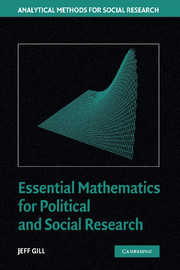Book contents
- Frontmatter
- Contents
- List of Tables
- List of Illustrations
- List of Examples
- Preface
- 1 The Basics
- 2 Analytic Geometry
- 3 Linear Algebra: Vectors, Matrices, and Operations
- 4 Linear Algebra Continued: Matrix Structure
- 5 Elementary Scalar Calculus
- 6 Additional Topics in Scalar and Vector Calculus
- 7 Probability Theory
- 8 Random Variables
- 9 Markov Chains
- References
- Author Index
- Subject Index
4 - Linear Algebra Continued: Matrix Structure
Published online by Cambridge University Press: 05 June 2012
- Frontmatter
- Contents
- List of Tables
- List of Illustrations
- List of Examples
- Preface
- 1 The Basics
- 2 Analytic Geometry
- 3 Linear Algebra: Vectors, Matrices, and Operations
- 4 Linear Algebra Continued: Matrix Structure
- 5 Elementary Scalar Calculus
- 6 Additional Topics in Scalar and Vector Calculus
- 7 Probability Theory
- 8 Random Variables
- 9 Markov Chains
- References
- Author Index
- Subject Index
Summary
Objectives
This chapter introduces more theoretical and abstract properties of vectors and matrices. We already (by now!) know the mechanics of manipulating these forms, and it is important to carry on to a deeper understanding of the properties asserted by specific row and column formations. The last chapter gave some of the algebraic basics of matrix manipulation, but this is really insufficient for understanding the full scope of linear algebra. Importantly, there are characteristics of a matrix that are not immediately obvious from just looking at its elements and dimension. The structure of a given matrix depends not only on the arrangement of numbers within its rectangular arrangement, but also on the relationship between these elements and the “size” of the matrix. The idea of size is left vague for the moment, but we will shortly see that there are some very specific ways to claim size for matrices, and these have important theoretical properties that define how a matrix works with other structures. This chapter demonstrates some of these properties by providing information about the internal dynamics of matrix structure. Some of these topics are a bit more abstract than those in the last chapter.
Space and Time
We have already discussed basic Euclidean geometric systems in Chapter 1. Recall that Cartesian coordinate systems define real-measured axes whereby points are uniquely defined in the subsequent space. So in a Cartesian plane defined by ℜ2, points define an ordered pair designating a unique position on this 2-space. Similarly, an ordered triple defines a unique point in ℜ3 3-space. Examples of these are given in Figure 4.1.
Information
- Type
- Chapter
- Information
- Essential Mathematics for Political and Social Research , pp. 132 - 177Publisher: Cambridge University PressPrint publication year: 2006
